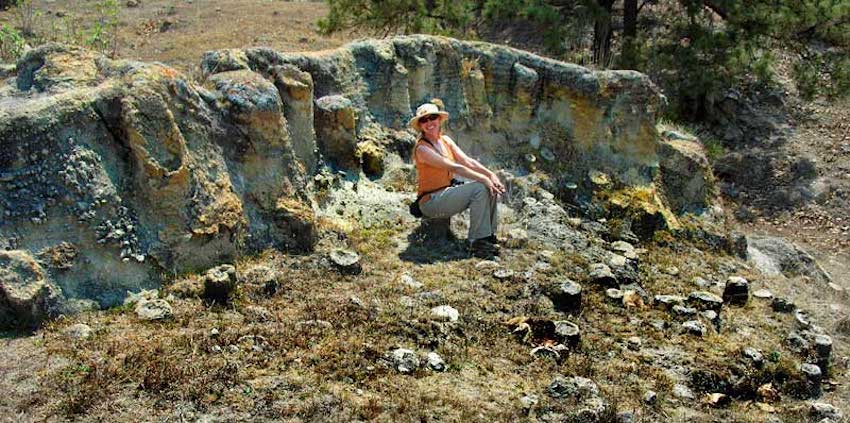Many years ago, while hiking through the huge Primavera Forest immediately west of the city of Guadalajara, I stumbled upon a strange sight. I quickly found myself calling it “The Great Wall.”

It was a cliff face about 70 meters (229.7 feet) long and 25 meters (82 feet) high. Protruding from this high wall I could see the tips of hundreds of cylinders of rock, piled one upon the other.
Many of these cylinders were perfectly round and about half a meter in diameter, but among them were others much fatter.
“What in the world is this?” I wondered.
The Great Wall was not easy to get to, and after a while, it faded from my memory. But very recently, I discovered an easier way to reach it — and something of an explanation as to what it is and how it came into existence.

That gigantic stack of stone cylinders turns out to be located only a 300-meter walk from a little park and campground hidden away deep inside the forest. The park is reachable via a better-than-average dirt road.
I couldn’t quite believe its name, but the place is seriously called Parque Recreativo La Hiedra, which means Poison Ivy Recreational Park. Believe it or not, I was told that I’d know I was going the right way to get there “if you pass a huge garbage dump along the way.”
Garbage and poison ivy? Those two things would keep people away from the Great Pyramid of Cheops!
Happily, I discovered that, despite the name, there is no poison ivy to be seen at Poison Ivy Park — and that the garbage dump is far enough away to cause no olfactory problems whatsoever.

On the contrary, Parque la Hiedra is quite simpático.
It just happens to be located alongside El Río Salado, (the Salty River), the warm, downstream section of the Río Caliente (The Hot River), one of the Primavera Forest’s most famous landmarks.
On top of that, this little park’s owners have managed to build a low dam with a sluice gate, creating a pool deep enough for swimming.
To visit the Great Wall from here, just go to the west (downstream) end of the park, where you’ll find an iron gate. Climb over, under or through the gate and walk west 300 meters (about 985 feet), following an old path that parallels the river. You’ll reach another iron gate that you must also climb over or under.

Now cross the river (barefoot or using water shoes), and you’ll be standing directly in front of the wall of pipes.
I suggest you walk over to the very base of the cliff, a distance of 100 meters (328 feet) from the river. Up close, you’ll see that some of the cylinders do look more like pipes than solid rods.
To understand what happened here, geologist Gail Mahood tells us we must go back 95,000 years to Jalisco’s version of the Big Bang: a huge explosion — one included in the list of the world’s large volcanic eruptions — which shot 40 cubic kilometers of volcanic ash and pumice straight up into the air while simultaneously spreading thick pyroclastic flows (a mass of very hot ash, lava fragments and gases) around the perimeter of a great hole called a caldera.
These flows of incandescent ash and pumice, known as the Tala Tuff, smothered the area.

Beneath this pyroclastic flow, there had been water in places, but it was instantly turned to steam. Bubbles of this water vapor then attempted to reach the surface, rising straight up through the hot ash, transforming the material it was passing through.
Eventually, when things cooled down, each pathway where bubbles had been rising solidified as an individual column or cylinder of rock, considerably harder than the surrounding ash.
Many centuries later, as the ash eroded away, the tips of these columns — technically called fumarolic pipes — protruded from the ground and became visible, resembling a forest of tree stumps.
In the case of the Great Wall, geological forces turned a large number of these columns sideways, which today gives it the look of a gigantic stack of horizontal pipes.It’s an impressive sight.

Geologist J. V. Wright is one of the world’s few researchers who has studied fumarolic pipes and in particular those of the Tala Tuff. I asked him how many other large walls of pipes have been reported elsewhere in the world.
Wright shared with me photos of two sites, one in the Bishop Tuff at Crowley Lake, California, and the other in the Bandelier Tuffs of New Mexico. Each is interesting in its own way, but, concluded Wright, the complexity of The Great Wall in the Tala Tuff is unique, “and nothing like it has ever been described.”
After hiking out to the Great Wall of Pipes, you can return to poison-ivy-free Parque la Hiedra for a swim in the deliciously warm, mineral-rich waters of the Salty River. The park is a safe and comfortable place to camp, should you be inclined.
La Hiedra has a large, flat, grassy meadow alongside the river, well shaded by rare, beautiful pinos tristes (Pinus Lumholtzii). The park also has changing rooms, clean toilets and running cold water. You can get there by asking for Parque Recreativo La Hiedra on Google Maps. The coordinates of the Great Wall, for those who may be interested, are N20.69432 W103.65953.
For fees and other information, call the park at 331 860 6791 (WhatsApp).
The writer has lived near Guadalajara, Jalisco, since 1985. His most recent book is Outdoors in Western Mexico, Volume Three. More of his writing can be found on his blog.
